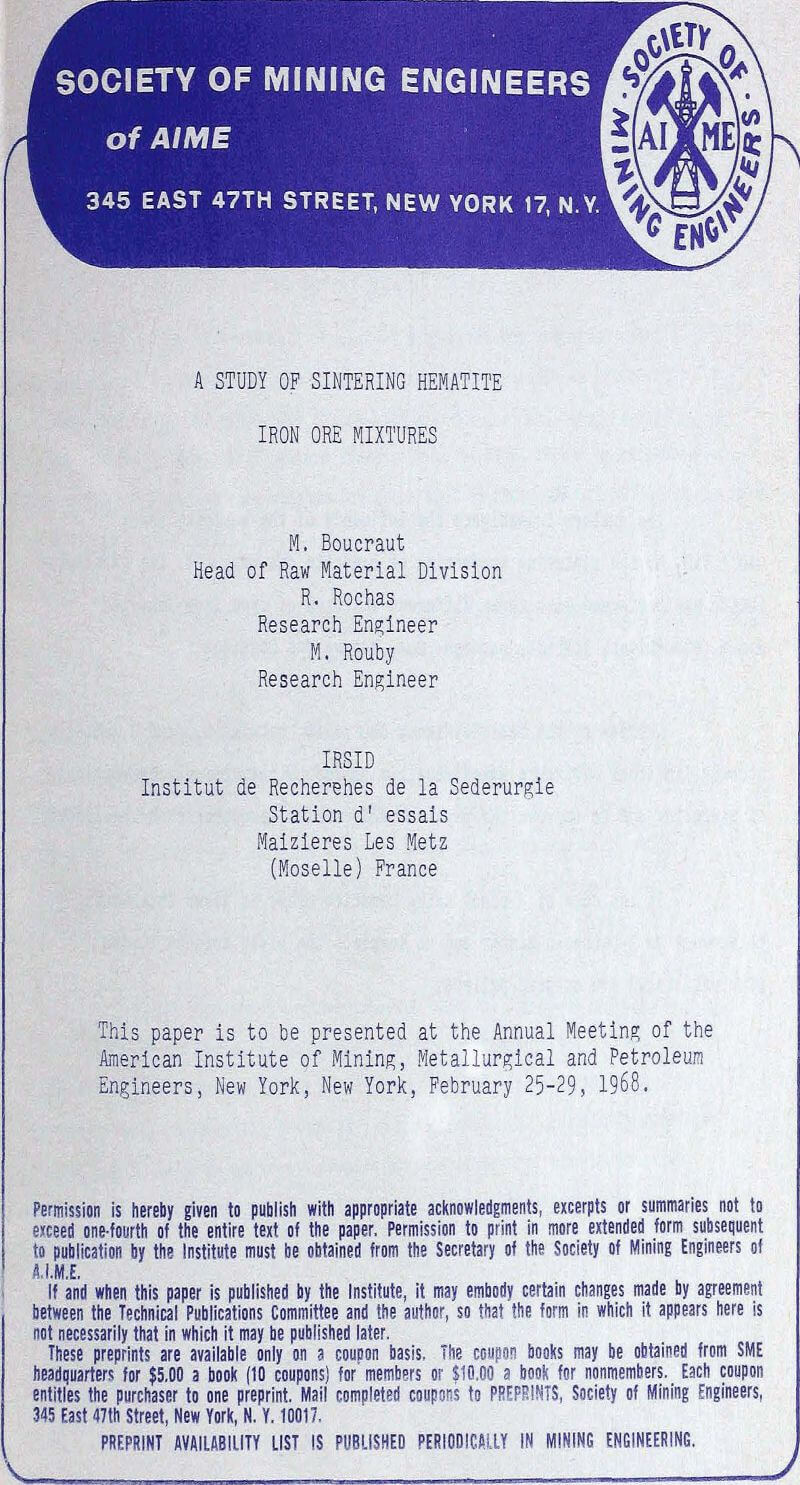Table of Contents
The authors investigate the influence of the basicity index CaO/SiO2 on the sintering properties of hematite ore mixtures. The experimentation was performed with three different mixtures of ores from Tazadit, Nimba, Mano-River, Itabira, Marcona, Goa, Mapawa and Cassinga. Increasing the basicity index CaO/SiO2 between 0.1 and 3, chiefly through limestone admixture makes possible to reduce the thermal consumption of sintering and to improve the physical and chemical properties of the sinter. In the case of a plant using hematite ores, it seems interesting to produce an hyperbasic sinter and to complete the blast furnace burden with calibrated ore or acid pellets.
Characteristic Data of Ores and Additive
In order to determine the effect of an increased basicity index on the sintering properties of several mixtures of hematite ores, we have considered three series of experiments:
- The first concerned a mixture of ores from Tazadit, Nimba and Mano-River
- The second concerned a mixture of ores from Itabira, Marcona and Mano-River.
- The third concerned a mixture of ores from Goa, Mapawa and Cassinga.
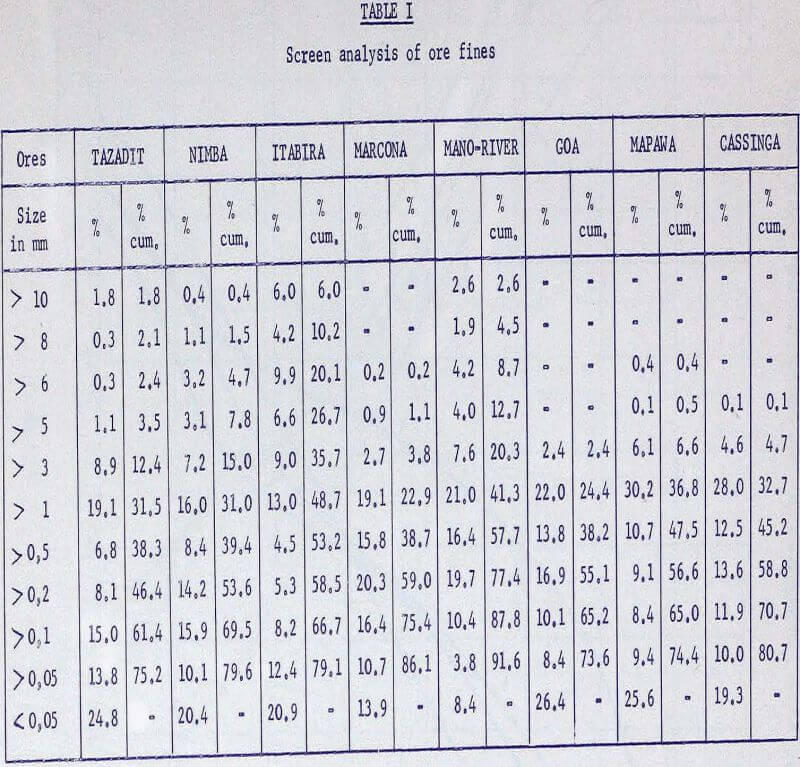
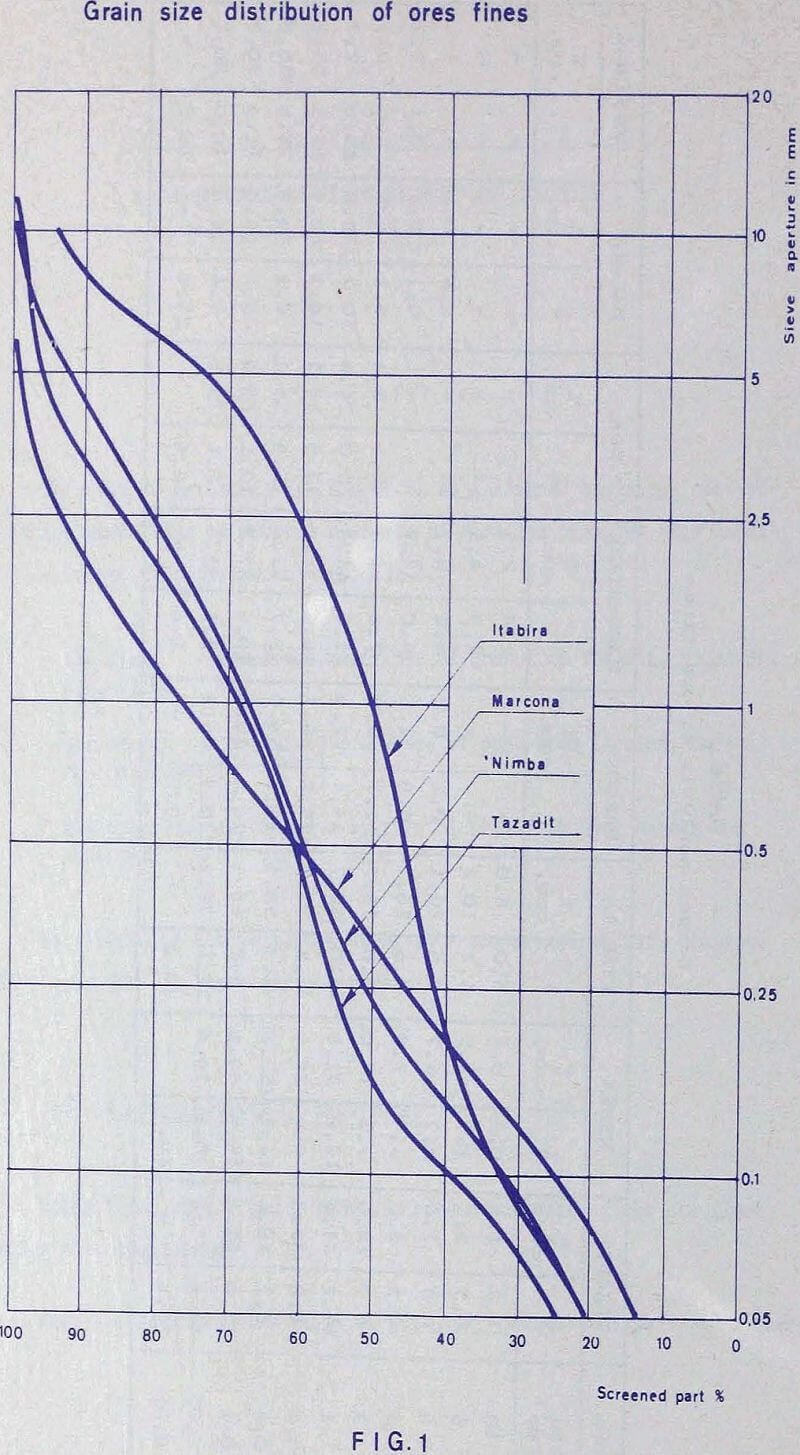
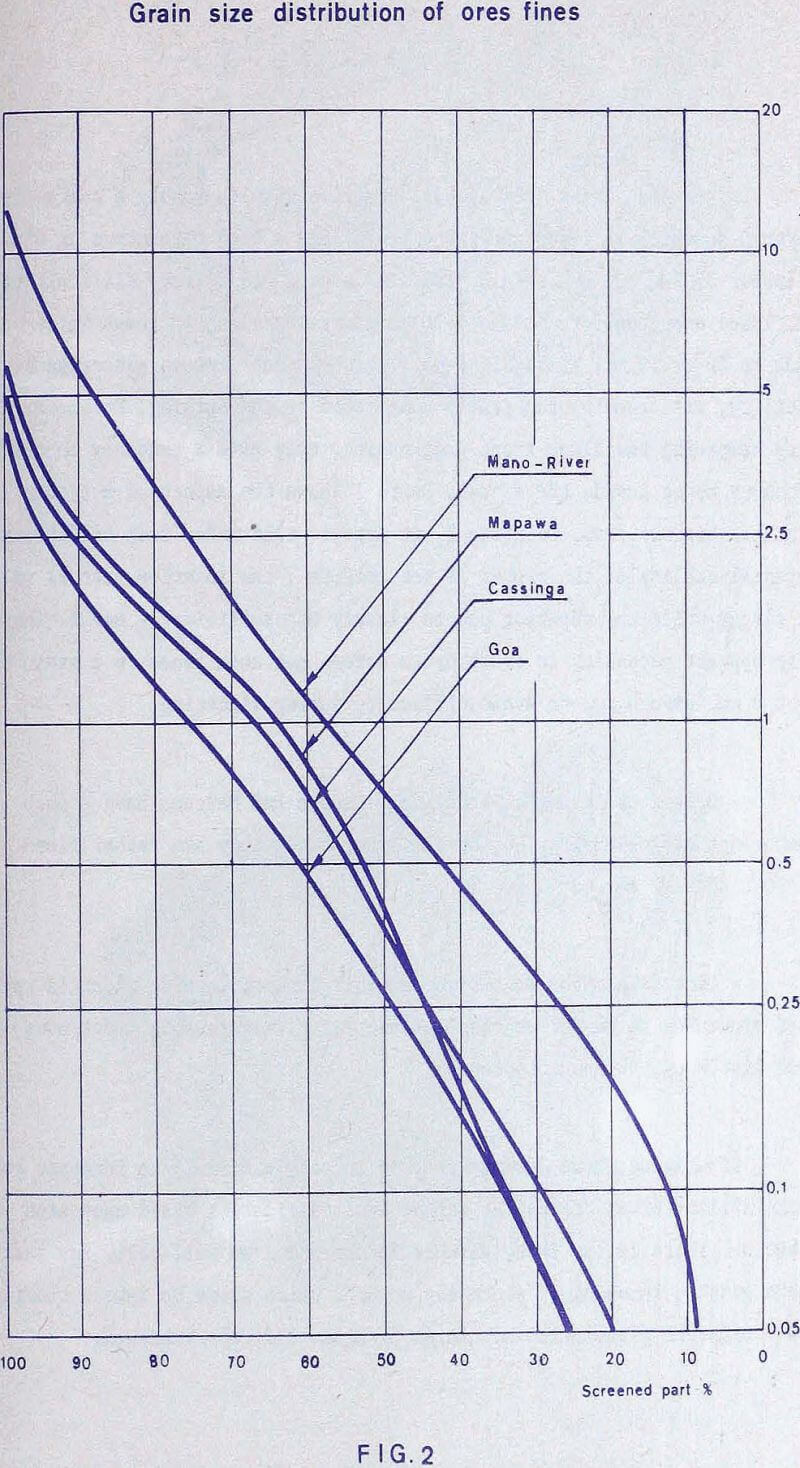
The ore fines from Itabira comprise simultaneously a coarse fraction over 5 mm which is important (about 25%) and a high percentage of ultrafines (about 33% < 100 µ). This lamellar looking ore is very difficult to screen. There are therefore in the 0-10 mm fines some longish lumps which can reach up to 40 or 50 mm. These big lumps, which do not improve sintering bed permeability, will remain practically unaffected by the burning. Moreover as they are hampering the flame front progression, they have a tendency to create heterogenous zones inside the sinter.
Experience shows however that it is very difficult to forecast the sintering ability of an ore and to define a classification based upon size distribution. There is, in fact, another factor which we will call, for lack of a more precise knowledge, “sintering power”, which seems to have a crucial influence upon the granulation mechanism of mixes and, there through,
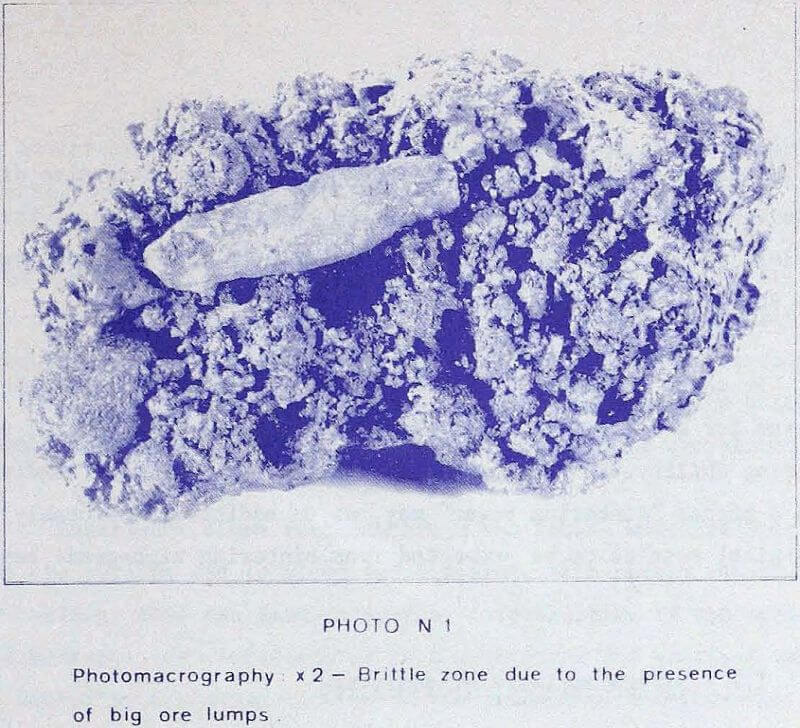

The ores utilized for the sintering experiments are of the type with predominant hematite with a siliceous gangue :
The various ores can be classified into three groups :
a) Banded hematite ores
The most typical among these is that of ITABIRA. It occurs in form of little conglomerated crystals of hematite. The size of the crystals is less then 100 microns. The gangue is scarce and generally consists of quartz.
b) The Marcona ore
The investigated samples show an mineralisation with predominant martite, i.e, a magnetite oxidized to hematite. The oxidation has taken place along the cleavage planes of the magnetite and on the edges of crystals.
c) “High sintering power” ores
Under this category we will group together the ores of Mano-River (Liberia), Cassinga (Angola), Mapawa (Bresil) and Goa (India).
Characteristic Data of the Experiments
In order to show the impact of an increase in basicity-index, chiefly through limestone admixture, on the sintering properties of hematite and hematite-goethite ores, an investigation was undertaken on the three following mixtures :

To each of these basic mixes, we added fluxes, and more particularly limestone, so as to obtain sinters with a basicity index CaO/SiO2 lying between 0.1 and 3.
Taking into account the big number of experiments which should have been necessary for a thorough investigation of the problem, we limited the scope of this research by fixing some operating data :
- Total bed height on the sintering strand………………………40 cm
- Suction under the grate…………………………………………….1100 mm of water
- Return fines rate related to dry mix (ores and admixtures)………..54%
- Sinter screen aperture……………………………………………………8 mm
Starting from the three 3-ores mixtures whose composition was given in the preceding paragraph, a plurality of experiments were effected with various admixtures to the sinter mix, but more specifically with limestone admixture so as to vary the basicity index CaO / SiO2 between 0.1 and 3.
Sinter Output
For given bed height, suction under the grate and rate of return fines, the sinter output is dependent on the sintering speed and on the finished sinter yield.
Former investigations by IRSID have shown that, for Lorraine ores, the sintering speed VG is related to the main parameters by the empirical law :

Vo being a speed of reference (fixed),
H the bed height
T the sintering time,
ΔP the suction under the grate,
and R the resistance to gas flow of the unit of bed height ; the latter is affected by :
- the specific parameters of the mix (“sintering power”, grain size, void index, etc) or in other words its permeability,
- the gas flow parameters and specifically its viscosity.
While the resistance to gas flow of low-grade ores of the Lorraine type is chiefly determined by the resistance in the not yet sintered layers (phenomenon of water recondensation), the conditions are not the same for the sintering of hematite ores.
Actually, the resistance may be indirectly measured through the volume of hot gases flowing through the sintering bed, i.e, in a first approximation through the air volume entering the bed. However, in a sintering operation two main periods must be considered :
- a first one during which the air-flow remains substantially constant and rather small, during a time t ;
- a second one (from the instant t tc the end of operation T) during which air-flow through the bed increases rapidly.
This permeability increase is explainable through a decrease of the resistance in the flame front. Indeed, and in agreement with a number of authors, limestone admixture to a sintering bed allows, above a definite value, on the one hand to lower appreciably the sintering temperature (about 100 to 150° C) and on the other hand to increase the external porosity of the bed (corresponding to the CO2 release).
As increasing the limestone admixture into the mix involves a diminution of the loading density and an increase of the ignition loss of the mix, the finished sinter yield decreases permanently.
It is quite clear, howevers that a too heavy admixture of limestone (basicity index over 2) produces a tendency towards a new increase of the thermal consumption (the operation efficiency being substantially constant while the specific needs are increasing).
These various results lead to the following important conclusions about the control of a sintering strand while sintering hematite ores :
- Any alteration of the basicity index may have a very big impact on the operating parameters of the strand, and specifically on the fuel consumption
- As for the stability of operation, i.e. the zones where a small alteration of the basicity index does not involve a large change in the adjustments, it appears on Fig 5 that there are three possible zones of operation :
hyperacid operation 0.1 < i < 0.6
self-fluxing operation 1 < i < 1.25
hyperbasic operation 1.75 < i < 2.10
where i = CaO / SiO2
Physical Quality and Structure
The study of a large number of sinters produced from the same mixture of hematite ores, but with various values of basicity index, establishes some relations between the structure and the physical quality.
As the investigated ores were high-grade ones, the quantity of gangue they bring in is very limited. When the limestone admixture is small or null, lie when the basicity index is low, the connection between iron oxide crystals (substantially magnetite) is effected chiefly by bridges between the crystals and consequently by a scarce, but rather stable vitreous phase. The Strength of the sinter is closely connectedto the resistance of magnetite and of the vitreous phase.
When the basicity index increases, while remaining under 1, a part of the vitreous phase develops hematite fayalite and olivine dendrites but this contributes only slightly to the resistance of the sinters.
When the basicity index lies between 1 and 1.3 the first crystals of calcium ferrite appear but also bicalcic silicate. Indeed, while the reaction in a solid phase between hematite and lime is more active that the reaction between lime and silica, in a liquid phase, the conditions are quite different : the calcium silicate which crystallizes more easily is the bicalcic silicate.
